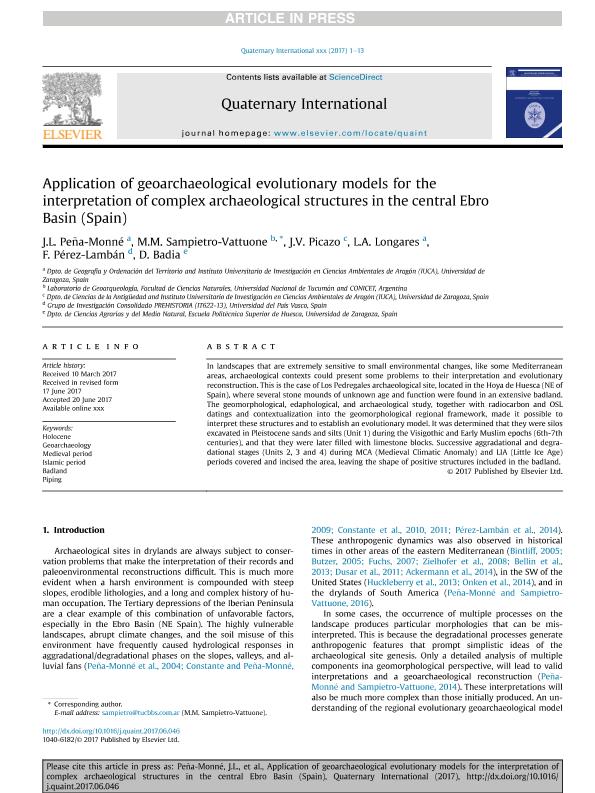Artículo
Application of geoarchaeological evolutionary models for the interpretation of complex archaeological structures in the central Ebro Basin (Spain)
Peña Monné, José Luis; Sampietro Vattuone, Maria Marta ; Picazo Millán, Jesús V.; Longares, Luis Alberto; Pérez Lambán, Fernando; Badia, D.
; Picazo Millán, Jesús V.; Longares, Luis Alberto; Pérez Lambán, Fernando; Badia, D.
 ; Picazo Millán, Jesús V.; Longares, Luis Alberto; Pérez Lambán, Fernando; Badia, D.
; Picazo Millán, Jesús V.; Longares, Luis Alberto; Pérez Lambán, Fernando; Badia, D.
Fecha de publicación:
07/2018
Editorial:
Pergamon-Elsevier Science Ltd
Revista:
Quaternary International
ISSN:
1040-6182
Idioma:
Inglés
Tipo de recurso:
Artículo publicado
Clasificación temática:
Resumen
In landscapes that are extremely sensitive to small environmental changes, like some Mediterranean areas, archaeological contexts could present some problems to their interpretation and evolutionary reconstruction. This is the case of Los Pedregales archaeological site, located in the Hoya de Huesca (NE of Spain), where several stone mounds of unknown age and function were found in an extensive badland. The geomorphological, edaphological, and archaeological study, together with radiocarbon and OSL datings and contextualization into the geomorphological regional framework, made it possible to interpret these structures and to establish an evolutionary model. It was determined that they were silos excavated in Pleistocene sands and silts (Unit 1) during the Visigothic and Early Muslim epochs (6th-7th centuries), and that they were later filled with limestone blocks. Successive aggradational and degradational stages (Units 2, 3 and 4) during MCA (Medieval Climatic Anomaly) and LIA (Little Ice Age) periods covered and incised the area, leaving the shape of positive structures included in the badland.
Palabras clave:
Badland
,
Geoarchaeology
,
Holocene
,
Islamic Period
,
Medieval Period
,
Piping
Archivos asociados
Licencia
Identificadores
Colecciones
Articulos(CCT - NOA SUR)
Articulos de CTRO.CIENTIFICO TECNOL.CONICET - NOA SUR
Articulos de CTRO.CIENTIFICO TECNOL.CONICET - NOA SUR
Citación
Peña Monné, José Luis; Sampietro Vattuone, Maria Marta; Picazo Millán, Jesús V.; Longares, Luis Alberto; Pérez Lambán, Fernando; et al.; Application of geoarchaeological evolutionary models for the interpretation of complex archaeological structures in the central Ebro Basin (Spain); Pergamon-Elsevier Science Ltd; Quaternary International; 483; 7-2018; 70-82
Compartir
Altmétricas



